Intel Core i7-10700 vs Core i7-10700K Review: Is 65W Comet Lake an Option?
by Dr. Ian Cutress on January 21, 2021 10:30 AM EST- Posted in
- CPUs
- Intel
- Core i7
- Z490
- 10th Gen Core
- Comet Lake
- i7-10700K
- i7-10700
CPU Tests: Encoding
One of the interesting elements on modern processors is encoding performance. This covers two main areas: encryption/decryption for secure data transfer, and video transcoding from one video format to another.
In the encrypt/decrypt scenario, how data is transferred and by what mechanism is pertinent to on-the-fly encryption of sensitive data - a process by which more modern devices are leaning to for software security.
Video transcoding as a tool to adjust the quality, file size and resolution of a video file has boomed in recent years, such as providing the optimum video for devices before consumption, or for game streamers who are wanting to upload the output from their video camera in real-time. As we move into live 3D video, this task will only get more strenuous, and it turns out that the performance of certain algorithms is a function of the input/output of the content.
HandBrake 1.32: Link
Video transcoding (both encode and decode) is a hot topic in performance metrics as more and more content is being created. First consideration is the standard in which the video is encoded, which can be lossless or lossy, trade performance for file-size, trade quality for file-size, or all of the above can increase encoding rates to help accelerate decoding rates. Alongside Google's favorite codecs, VP9 and AV1, there are others that are prominent: H264, the older codec, is practically everywhere and is designed to be optimized for 1080p video, and HEVC (or H.265) that is aimed to provide the same quality as H264 but at a lower file-size (or better quality for the same size). HEVC is important as 4K is streamed over the air, meaning less bits need to be transferred for the same quality content. There are other codecs coming to market designed for specific use cases all the time.
Handbrake is a favored tool for transcoding, with the later versions using copious amounts of newer APIs to take advantage of co-processors, like GPUs. It is available on Windows via an interface or can be accessed through the command-line, with the latter making our testing easier, with a redirection operator for the console output.
We take the compiled version of this 16-minute YouTube video about Russian CPUs at 1080p30 h264 and convert into three different files: (1) 480p30 ‘Discord’, (2) 720p30 ‘YouTube’, and (3) 4K60 HEVC.
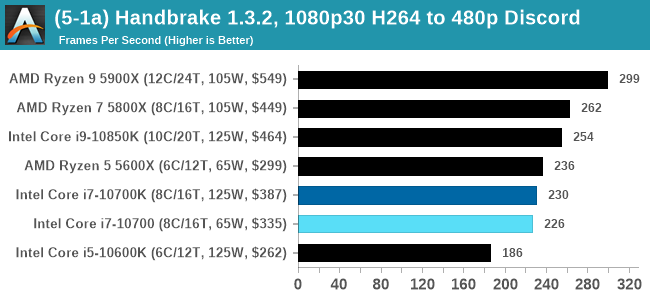

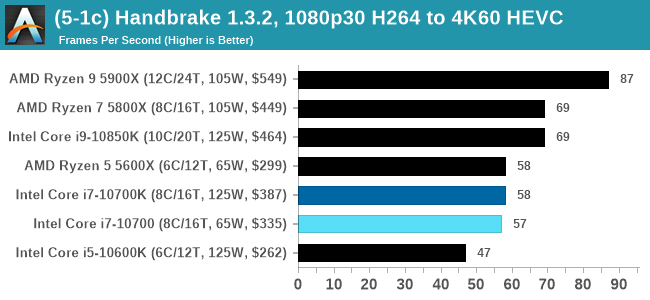
7-Zip 1900: Link
The first compression benchmark tool we use is the open-source 7-zip, which typically offers good scaling across multiple cores. 7-zip is the compression tool most cited by readers as one they would rather see benchmarks on, and the program includes a built-in benchmark tool for both compression and decompression.
The tool can either be run from inside the software or through the command line. We take the latter route as it is easier to automate, obtain results, and put through our process. The command line flags available offer an option for repeated runs, and the output provides the average automatically through the console. We direct this output into a text file and regex the required values for compression, decompression, and a combined score.
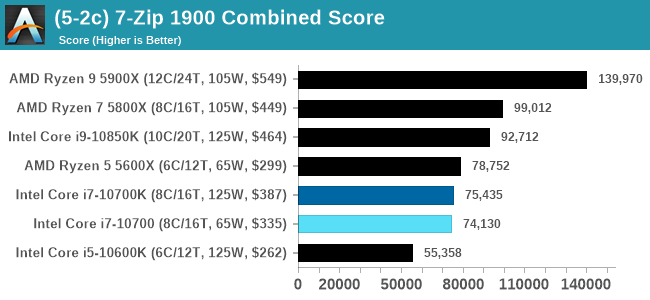
AES Encoding
Algorithms using AES coding have spread far and wide as a ubiquitous tool for encryption. Again, this is another CPU limited test, and modern CPUs have special AES pathways to accelerate their performance. We often see scaling in both frequency and cores with this benchmark. We use the latest version of TrueCrypt and run its benchmark mode over 1GB of in-DRAM data. Results shown are the GB/s average of encryption and decryption.
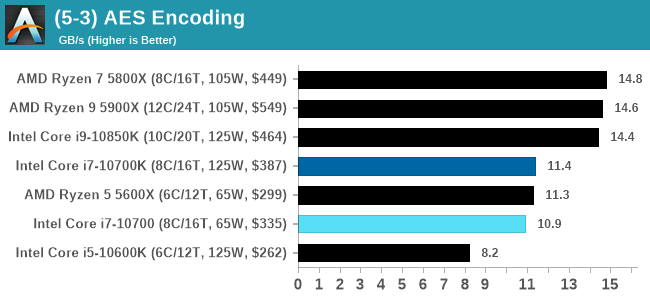
WinRAR 5.90: Link
For the 2020 test suite, we move to the latest version of WinRAR in our compression test. WinRAR in some quarters is more user friendly that 7-Zip, hence its inclusion. Rather than use a benchmark mode as we did with 7-Zip, here we take a set of files representative of a generic stack
- 33 video files , each 30 seconds, in 1.37 GB,
- 2834 smaller website files in 370 folders in 150 MB,
- 100 Beat Saber music tracks and input files, for 451 MB
This is a mixture of compressible and incompressible formats. The results shown are the time taken to encode the file. Due to DRAM caching, we run the test for 20 minutes times and take the average of the last five runs when the benchmark is in a steady state.
For automation, we use AHK’s internal timing tools from initiating the workload until the window closes signifying the end. This means the results are contained within AHK, with an average of the last 5 results being easy enough to calculate.
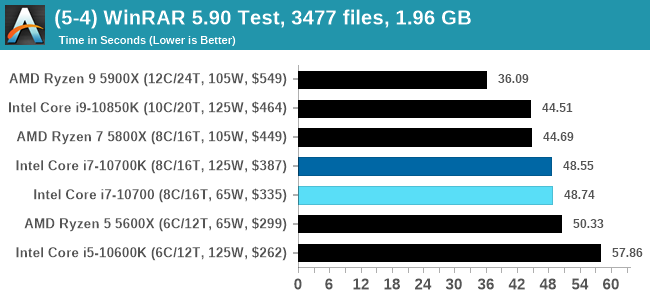


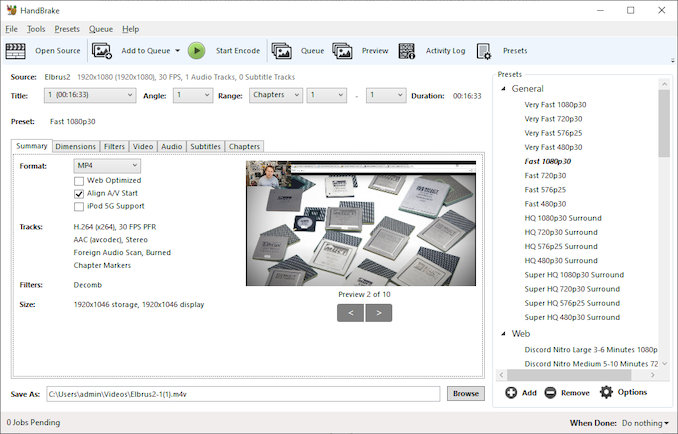
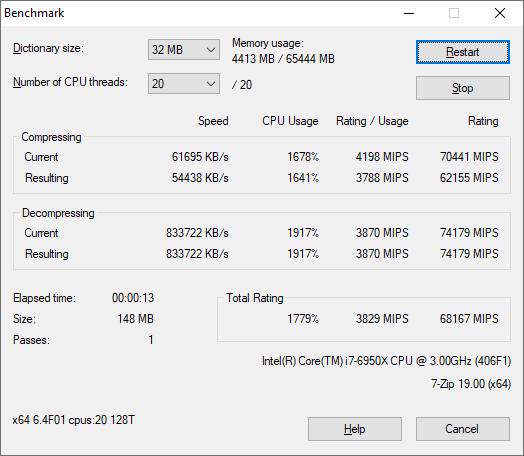









210 Comments
View All Comments
Oxford Guy - Monday, January 25, 2021 - link
'What if I don't agree about the location of the "sweet spot" based on RAM prices local to me, or my own performance needs?'Price vs. performance is a different topic. Nice attempt to change the subject, though.
Spunjji - Wednesday, January 27, 2021 - link
It's not at all an attempt to change the subject. The point is that the issue of an "optimal" RAM speed is a moving target dependent on multiple variables.Makste - Saturday, January 23, 2021 - link
As a part of his audience, I am actually satisfied with this review, as I am looking for the out of the box experience. I'm most likely not to tamper with the manufacturer's recommendations. So he tested the CPUs following both Intel and AMD recommendations. Something I don't see a problem with.Oxford Guy - Sunday, January 24, 2021 - link
Turning on XMP is hardly tampering, particularly since motherboard vendors provide lists of recommended RAM to use those XMP profiles with.theqnology - Monday, January 25, 2021 - link
If it shouldn't be the case, shouldn't consumers take it up with Intel, and not with the reviewer? Why does Intel put lower max than the current JEDEC standards (e.g., Intel at 2933 while AMD at 3200)? I ask, if Intel was so confident about their products, why not up the official support?This is really the crux of it. Intel wants to make it part of the difference between their Z boards and their non-Z boards, which adds more cost for the consumers, while at the same time washing themselves from this responsibility should something not work (you cannot RMA based on non-JEDEC compatibility). It is also fascinating that consumers think this is on the reviewers.
Oxford Guy - Monday, January 25, 2021 - link
Sure, as long as the reviewer is consistent with the logic.That means no reviewing boards that violate the official base clock and turbo behavior.
Things like that.
Spunjji - Wednesday, January 27, 2021 - link
Then he can't review any board at all.Honestly, this "everything must be treated exactly the same otherwise nothing is fair" rhetoric is ghastly and corrosive in whatever domain it's applied.
Qasar - Thursday, January 28, 2021 - link
" That means no reviewing boards that violate the official base clock and turbo behavior. "considering that intel doesnt make board makers conform to anything as far as what " default " would be, good luck with this.
quiq - Sunday, January 24, 2021 - link
i want to view the 1070 whit stock box and a h410/470 motherboard thats the real user for a non k cpuvs 10700k and z490 aftermarket HeatSink or WC Oc memories etc Real entusiast cpu
IanCutress - Saturday, January 23, 2021 - link
Please go ahead and enforce both Intel and AMD to rate their memory controllers faster then. Its not opinion, it's the literal standard,and the only way to ensure consistency for comparisons across generations. I'm not going to offer one CPU a higher dram overclock than another, that isn't fair, just in the same way I'm not going to overclocked the cores. I regularly dive into AT's audience metrics, and have done for years. If you want data that's different, then please by all means either do your own testing or find other reviews. But you know, also get them to deep dive into microarchitecture as well as get all the behind the curtain info. Also, all our content is free at the point of use. By your logic, I'm also a consumer of content at AT, thus I also pay my salary. Please enjoy.